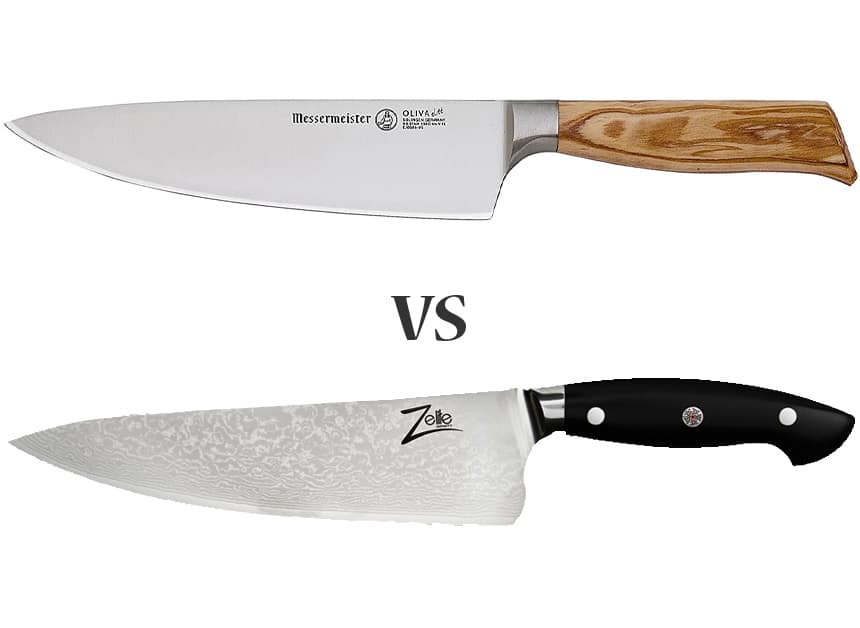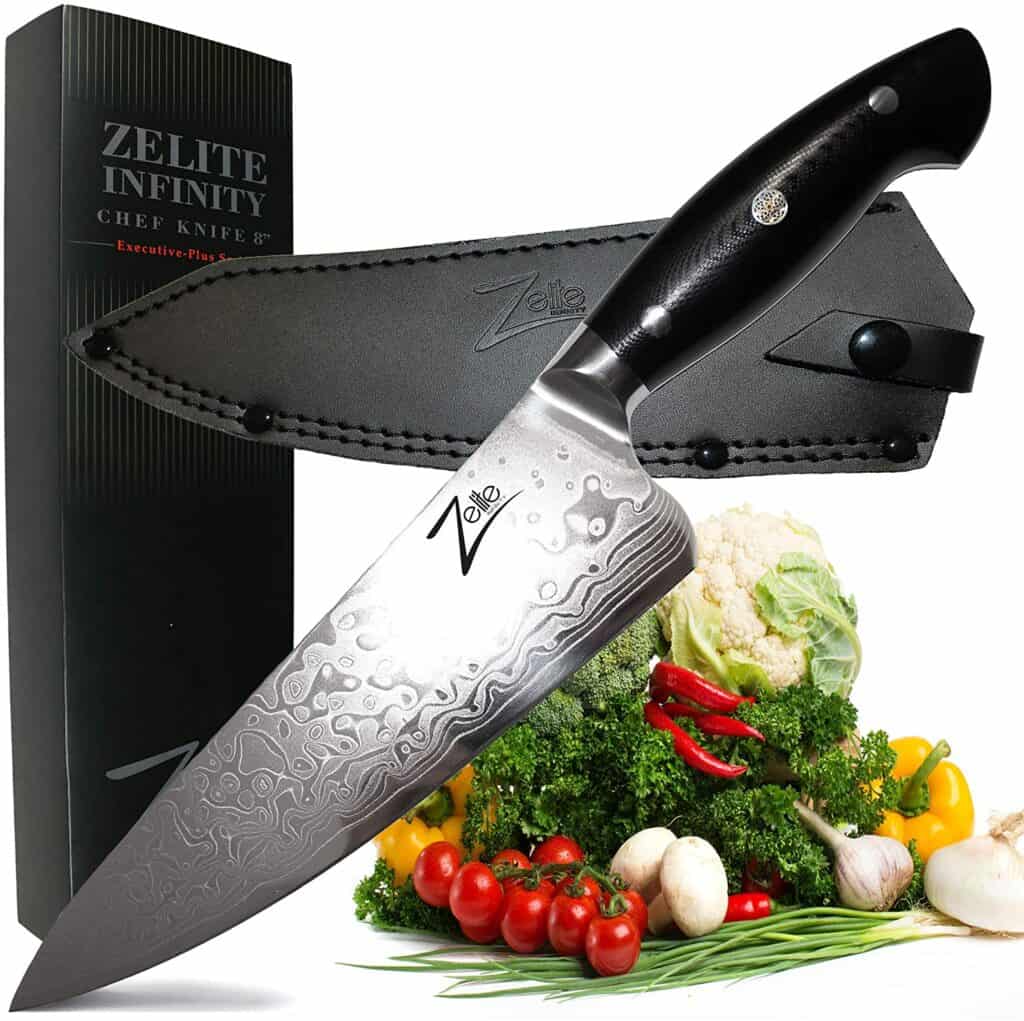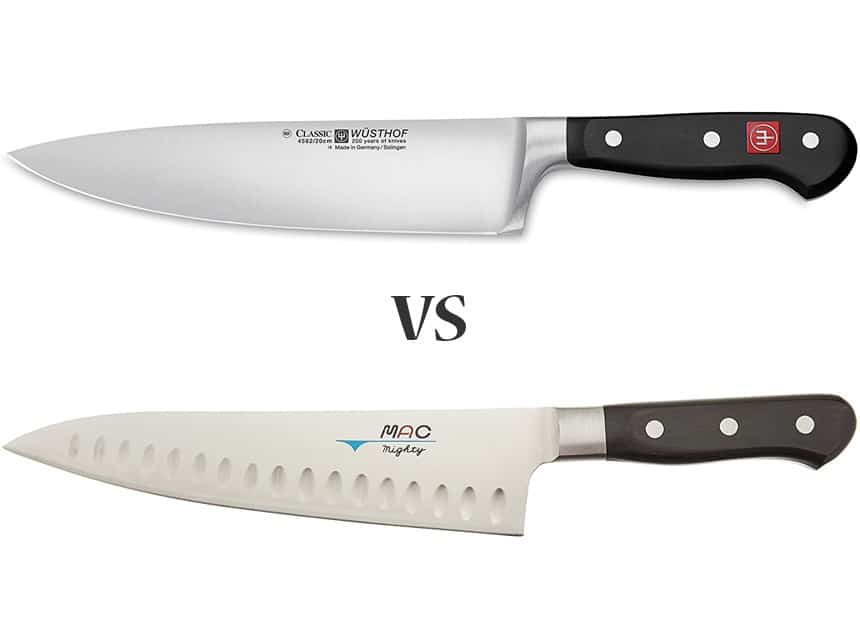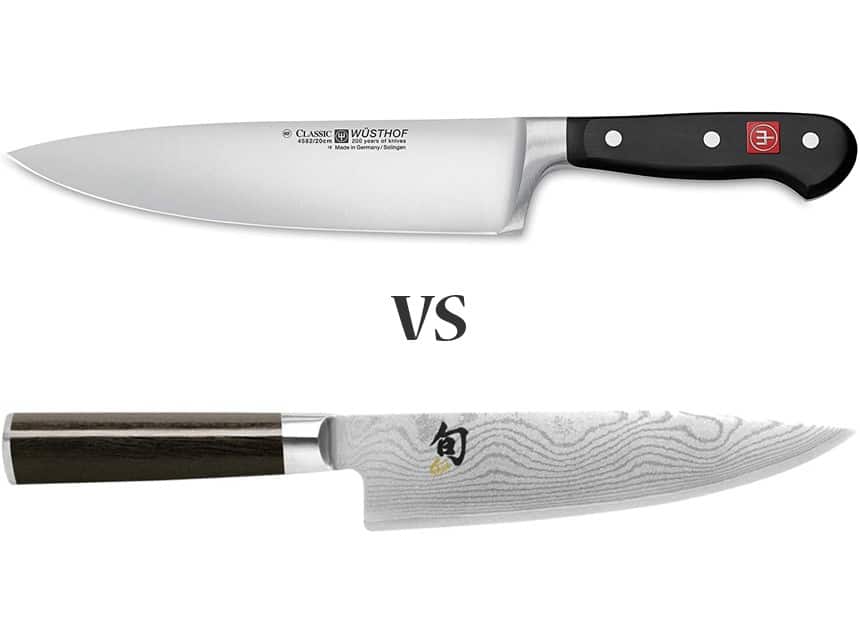
Chinese knife brands are really bursting onto the scene.
Some of these new Chinese brands are using quality materials to produce a product that is comparable with high-quality Western and Japanese knives..
One such brand is Zelite, and this article is here to answer any questions you have if you’re deciding between a Zelite and Messermeister knife.
In this article, I’m going to tell you the differences between these two brands. I’ll go in-depth into the details of each, talking about where they are made, what materials are used and the difference in price.
This article should provide all the information you need to select the right knife for your needs.
Messermeister knives are extremely durable so are ideal for busy family or professional kitchens. Zelite knives are very budget-friendly and their Japanese series offers a much sharper edge than Messermeister knives, but the harder steel does mean they are more brittle and so less durable than Messermeister.
| My recommendation | Current price |
| Messermeister Oliva Elite 8-Inch | View on Amazon (opens new tab) |
| Zelite Executive Plus 8-Inch Chef’s Knife | View on Amazon (opens new tab) |
Messermeister vs Zelite – Comparison Table
Here is my summary comparison table for each brand. This is mostly based on their most popular knives; the Messermeister Meridian Elite and the Zelite Executive Plus chef’s knife.
For a more in-depth look at each category then check out the rest of the article below.
| Category | Messermeister | Zelite |
| Country of Manufacture | Germany | China |
| Steel type | X50CrMoV15 (1.4116) | AUS-10 (other ranges use VG10 and X50CrMoV15) |
| Rockwell hardness | HRC 57 | HRC 61 |
| Factory edge | 15 degrees (double bevel) | 12 degrees (double bevel) |
| Handle material | POM (thermoplastic) | G10 (fiberglass laminate) |
| Price range | $150 – $170 (Meridian Elite) | $130 – $140 (Executive Plus) |
| Main benefit | More durable | Lower price and sharper |
| My recommendation | Messermeister 8-Inch Meridian Elite (view on Amazon) | Zelite Executive Plus (view on Amazon) |
Messermeister vs Zelite – Where are they made
| Brand | Country of manufacture |
| Messermeister | Germany |
| Zelite | China |
Messermeister Knives are produced in the German city of Solingen, where they have been produced since their launch in 1985.
Messermeister is German for Knife (Messer) Maser (Meister), they have always had a focus on innovative design whilst still being influenced by German classics.
Bernd Dressler, the founder of Messermeister was the first western knife maker to introduce a bolsterless heel to his knife range, a trend that is found throughout western knives today.
Zelite manufactures it’s knives in Yangjiang, China.
Zelite is a relatively small, family-owned business. On the face of it, the fact that Zelite knives are manufactured in China might be a little off-putting.
Let’s be honest, when we see the words ‘Made in China’ we usually think that the quality isn’t going to be great, but with Zelite I think there are some large benefits from having production based there.
They still use quality materials, but as the manufacturing costs are kept low these savings are passed onto the customer.
Zelite provides a range of both Japanese and German-influenced knives, in this article though I’m mainly focusing on their most popular Japanese style Executive Pro.
Messermeister is the ‘real-deal’ in regard to being produced directly in the heartland of its German heritage, whilst Zelite is perhaps less authentic.
That’s the beginning of the differences between these knives, but there are more, starting with the steel.
Messermeister vs Zelite – What steel do they use
The steel used in knives will often change depending on which range you pick.
This is particularly true of Zelite. They use a number of different steels throughout their ranges as they have both German and Japanese influenced knives.
Their German series uses X50CrMoV15 (the same as Messermeister) and their Japanese series use both AUS-10 and VG-10 depending on the range.
For a fair comparison, I’m going to focus on the most popular range for both Messermeister and Zelite knives.
For Messermeister that’s their Meridian Elite range and for Zelite it’s their Executive Plus range.
| Brand | Steel type | Rockwell hardness |
| Messermeister Meridian Elite | X50CrMoV15 (1.4116) | HRC 57 |
| Zelite Executive Pro | AUS-10 | HRC 61 |
Which steel a knife uses is often the best insight into its influence, and what functionality the brand has placed most focus on.
Messermeister uses X50CrMoV15. This is a German steel that is used for the majority of Messermeister knives.
It’s popular steel amongst producers of quality western-style knives. That’s because it has a particular focus on durability, whilst retaining enough strength for a sharp edge.
The main elements of interest within X50CrMoV15’s composition are Carbon, Vanadium and Chromium.
The Carbon content is 0.55%. That’s not particularly high when comparing it with other quality knives; however, it’s high enough to provide sufficient strength in the blade for a 15 – 20 degree angle on each side, which is standard for western knives.
The big benefit of not having a very high Carbon content is that higher Carbon steels are usually more brittle, therefore the 0.55% content keeps the blade durable.
That’s the same with the strong Vanadium of 0.4%, Vanadium improves the resistance to wear of the steel also adding to its durability.
The Chromium content is 15% is what the 15 in X50CrMoV15 represents. Chromium is vital for the durability of steel as it’s what makes stainless steel resistant to rust.
Steel need only be 10.5% to be considered stainless, so a 15% content is high and makes this a quality stainless steel, very unlikely to rust unless extremely mistreated by the owner.
The Zelite Executive Plus range uses Japanese steel AUS-10. Other Zelite knives use X50CrMoV15 (for their German range) and VG-10 (another Japanese steel).
This is where we start to see the benefits of Zelite knives, the materials they use are very good quality, in this case, imported from Japan, but the Chinese manufacturing reduces the cost to the consumer.
AUS-10 is a Japanese steel with a great reputation. It’s a high carbon steel, with a Carbon content between 0.95% – 1.1%.
That means the steel is hard, allowing it to hold a sharper edge for longer.
The Chromium level is also high at 13% – 14.5%. It’s not as good as the Messermeister but it’s still enough to make AUS-10 a quality stainless steel and therefore very rust-resistant.
The trade-off here is sharpness for durability. The Messermeister’s X50CrMoV15 steel is more durable than AUS-10, the high Carbon Zelite knife can hold a sharper edge but it will be more brittle and thus more prone to chipping along the edge.
That hardness is clearly shown in the Rockwell scale score, where the Zelite Executive Plus knives have a much higher HRC than the Messermeister Meridian Elite, standing at 61 compared with 57.
Messermeister vs Zelite – How sharp are they
Once again I’m going to focus on the most popular knives from each brand for this comparison. That’s the Messermeister Meridian Elite and Zelite Executive Pro.
You will experience a much sharper edge using Zelite knives than Messermeister knives. The factory edge is finer and the steel is significantly harder. Messermeister knives are primarily focused on durability rather than sharpness.
| Brand | Factory edge | Rockwell hardness |
| Messermeister Meridian Elite | 15 degrees (double bevel) | HRC 57 |
| Zelite Executive Pro | 12 degrees (double bevel) | HRC 61 |
When it comes to sharpness it’s often the angle of the blade that will be advertised, but actually, the hardness of the steel is probably more important.
Often people will look at the knife with the smallest angle and say that’s the sharpest, but in practicality, this isn’t quite true.
Harder knives will hold a sharper edge for longer. Often knives with a larger angle, but harder steel will actually perform better for sharpness than a softer steel with a more acute angle, as soft steel can’t retain an acute angle for long.
With that being said, Zelite offers the best of both worlds when it comes to sharpness.
The AUS-10 high Carbon steel has a Rockwell hardness of HRC 61, meaning it can retain a very sharp edge.
Combine that with the razor-sharp 12 degree out-of-the-factory angle on the blade and the Zeilte is by far the sharper knife of the two.
Zeilte uses Japanese steel and that tends to have a focus on hardness, in order to create a sharper edge.
Messermeister knives will dull much more quickly than Zelite knives and to maintain even the 15-degree factory angle they would have to be sharpened very frequently.
However; the benefit of using softer steel is that Messermeister knives will be much more durable. Since the Zelite uses a harder steel it will be more brittle.
Combine that with the very acute 12-degree angle and Zelite knives will be more prone to chipping along the edge if they are not looked after carefully.
Overall though, this is a clear win for Zelite and is probably its best feature.
Messermeister vs Zelite – What are the handles made from
The material used for handles is a vital and often overlooked feature of any knife.
A quality handle is often the sign of a quality overall knife. Handles need to be made from a durable material that can withstand all the heat and moisture fluctuations knives can experience in the kitchen.
Once again we’ll focus on the two main ranges from each brand, the Messermeister Meridian Elite and Zelite Executive Plus knives.
| Brand | Handle material |
| Messermeister Meridian Elite | POM (thermoplastic) – Although other Messermeister ranges use stunning timber for the handle |
| Zelite Executive Pro | G10 (fiberglass laminate) |
Messermeister use a thermoplastic material called POM (Polyoxymethylene) for their Meridian Elite knife handles.
Although, it is worth mentioning that Messermeister use some very attractive timbers for their other ranges such as Royale Elite (American Walnut) and Oliva Elite (Olive Wood) that are exquisitely beautiful.
But for now, let’s focus on POM as that is used by their main range. Materials like these are ideal for knife handles due to their extreme durability.
POM is specifically designed for high stiffness and stability, and being a thermoplastic means it’s also extremely resistant to temperature and moisture changes.
It’s a fantastic material to use for knife handles, that will undergo all sorts of pressures and it makes sense to use this material for your main range, which is usually your more practical range.
However, as I’ve mentioned above, Messermeister in particular has some stunning handles in their other collections. I particularly like the Olive Wood handle used in their Oliva Elite collection.
So, although their main range uses the same handle material, I’d say the exquisite timber used by Messermeister.
I’ll link to the Messermeister Oliva Elite Chef’s knife at the bottom of this article, it’s well worth a look.
Zelite uses a fiberglass laminate called G10 for their Executive Plus knife handles. Not all Zelite knives use G10 but all Zelite ranges do use good quality materials for their handles such as Pakkawood.
G10 is a fiberglass laminate, making it a fantastic material for knife handles.
It has the perfect combination of being extremely lightweight and very tough. It will be able to withstand any of the standard pressure of a kitchen.
Zelite focuses quite heavily on making comfortable handles and their knife ranges do use a variety of materials for their handles, not just G10.
But they always use quality materials, such as Pakkawood for their Alpha-Royal Japanese Series, a quality wood/resin material commonly used as a material by traditional Japanese knife manufacturers.
So whichever range of Zelite knives you choose, you can be confident that the handle will be a quality, durable and comfortable one.
Messermeister vs Zelite – How much do they cost
Both these brands have wide ranges of knives all at differing price ranges.
To allow for a fairer comparison I’ve categorized three of their major ranges that represent their highest and lowest cost knives.
I’ve tried to compare similar knives, sticking to 8 Inch Chef’s knives or the closest equivalent they have in the range.
In brackets next to the general price range you’ll see the name of the range.
These prices are rough estimates. Prices do change over time but this is intended as a rough guide.
| Brand range | Messermeister | Zelite |
| Premium | $170 – $190 (Oliva Elite) | $140 – $150 (Executive-Plus Series Master) |
| Standard | $150 – $170 (Meridian Elite) | $130 – $140 (Executive-Plus Series) |
| Value | $35 – $45 (Four Seasons) | $50 – $60 (Alpha-Royal German Series) |
As is clear to see, Zelite knives are consistently lower in price than Messermeister.
Typically Zelite’s German-influenced 8-inch Chef’s knives are around $50 – $60 and their Japanese influenced Chef’s knives are around $130 – $150.
That’s vastly lower than the Messermeister knives and a lot of the difference is because Zelite manufactures their knives in China.
However, their materials are still top quality, their German series uses the same X50CrMoV15 german steel that Messermeister uses and their Japanese series uses either AUS-10 or VG-10, both steels that can be found in Japanese knives easily costing over $200.
These steels are all made in either German or Japan and then exported to China for assembly of the knife.
For me, that makes Zelite incredibly good value and it justifies the fact they are produced in China.
Frankly, if you found a knife using the same materials as Zelite, but manufactured in their heartland (German or Japan), they would easily cost 50% – 100% more than Zelite knives do.
So if you’re looking for a quality knife on a budget, Zelite is the winner here.
Messermeister vs Zelite – What is the difference
Now that we have looked at the design, materials, background and price of these brands we can fully understand the difference, and you should be able to make an informed decision on which knife is correct for you.
The main differences between Messermeister and Zelite knives are that Messermeister knives are super durable, but Zelite knives cost less and their Japanese series are far sharper.
| Brand | Main benefits |
| Messermeister | More durable |
| Zelite | Lower price and sharper |
Zelite offers the sharper blade. That’s only the case for their Japanese series but those still cost less than the Messermeister.
Zelite’s German series will be relatively similar in sharpness to Messermeister as they’re made from the same X50CrMoV15 steel.
Zelite knives also cost less. Their German series tend to be around the $50 mark and their Japanese series are around the $140 mark, both lower than the Messermeister Meridian Elite range and for the quality of materials they use the prices are very low.
Like most western-style knives, Messermeister knives are purpose-built for durability..
They use classic design and quality durable materials to create a knife that will last, even if it’s not treated particularly well.
With that understood, it should now be easy to choose between the two knives.
Messermeister vs Zelite – Which is better for you
I have to stress that these are both brilliant knives in their own way. There is no clear winner, it’s really down to which one suits your needs the best.
For a busy family kitchen, where multiple people might be using the knife, then I would recommend the Messermeister.
Messermeister makes very durable and beautiful knives.
If you want a knife that is guaranteed to last, Messermeister is the best choice.
If sharpness or budget is your main concern, then the Zelite is the best choice for you.
The Japanese series of knives Zelite offers are made from very high quality and hard steel, so they can retain a much sharper edge than a Messermeister ever could.
That does mean they are more brittle though. As a result, the edge will be more prone to chipping than the softer Messermeister, so storing a Japanese series Zelite in a knife block or sheath and hand cleaning is a must.
Because they are made in China, they also cost significantly less than knives using the exact same standard of materials but manufactured in Japan.
This is also true for Zelite’s German series of knives. They don’t have the benefit of being super-sharp, because they are made with the same X50CrMoV15 as the Messermeister, but for the quality, they generally cost quite a bit less.
If you’re looking for a quality knife on a budget, go with Zeilte.
If you are after the best in durability for a busy kitchen, go with Messermeister.
My Messermeister Recommendation

View the 8-Inch Messermeister Oliva Elite on Amazon (opens new tab)
For my Messermeister recommendation I’ve gone with one from their premium collection, especially the Oliva Elite collection.
This knife is stunning. I think it’s the most attractive western style Chef’s knife available.
The Olive Wood handle gives it such a beautiful finish that it really stands out from other knives.
Olive wood won’t be quite as durable as other thermoplastic handles, so you will have to avoid doing things like soaking it in the kitchen sink, because that’s clearly going to warp the wood over time.
But as timber goes, Olive wood is still a good material for knife handles, it’s hard and strong so it will be durable, it’s just hard to match the artificially created durability of substances like POM with natural materials.
It’s a great knife, so if you want to add a bit of beauty to your kitchen then there are few better choices than this Messermeister Oliva Elite.
My Zelite Recommendation

View the 8-Inch Zelite Executive Plus on Amazon (opens new tab)
If you’re after the razor-sharp edge offered by Japanese steel, but don’t want to pay the cost of a Japanese manufactured knife, then the Zelite Executive Plus is a great choice.
As a comparison, the Miyabi Kaizen II 8-inch Chef’s Knife, which is a quality, Japanese knife made in Japan, uses steel of the same hardness but costs around 50% more than the Zelite Executive Plus.
The Executive Plus series in particular also has a very ergonomically designed handle, using G10 to make it very lightweight and curved to perfectly fit into the palm of your hand.
It’s a great knife, for a great price. If you’re on a budget but still looking for quality, you can go far wrong with this.
In fact, you could get the Zelite Executive Plus and a Zelite Comfort-Plus Series and still pay less than you would for one Japanese made knife.
That way you have the best of both worlds, one super sharp Japanese steel knife and one durable German steel knife.

